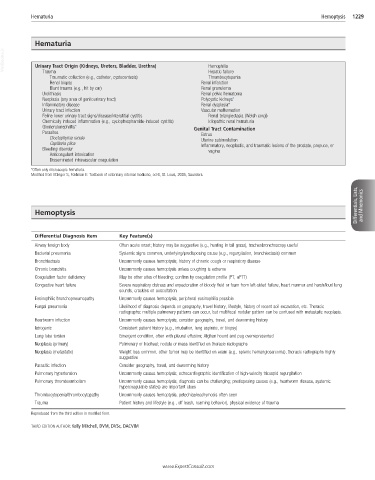Page 2475 - Cote clinical veterinary advisor dogs and cats 4th
P. 2475
Hematuria Hemoptysis 1229
Hematuria
VetBooks.ir Urinary Tract Origin (Kidneys, Ureters, Bladder, Urethra) Hemophilia
Trauma
Traumatic collection (e.g., catheter, cystocentesis) Hepatic failure
Thrombocytopenia
Renal biopsy Renal infarction
Blunt trauma (e.g., hit by car) Renal granuloma
Urolithiasis Renal pelvic hematoma
Neoplasia (any area of genitourinary tract) Polycystic kidneys*
Inflammatory disease Renal dysplasia*
Urinary tract infection Vascular malformation
Feline lower urinary tract signs/disease/interstitial cystitis Renal telangiectasia (Welsh corgi)
Chemically induced inflammation (e.g., cyclophosphamide-induced cystitis) Idiopathic renal hematuria
Glomerulonephritis* Genital Tract Contamination
Parasites Estrus
Dioctophyma renale Uterine subinvolution
Capillaria plica Inflammatory, neoplastic, and traumatic lesions of the prostate, prepuce, or
Bleeding disorder vagina
Anticoagulant intoxication
Disseminated intravascular coagulation
*Often only microscopic hematuria.
Modified from Ettinger S, Feldman E: Textbook of veterinary internal medicine, ed 6, St. Louis, 2005, Saunders.
Differentials, Lists, and Mnemonics
Hemoptysis
Differential Diagnosis Item Key Feature(s)
Airway foreign body Often acute onset; history may be suggestive (e.g., hunting in tall grass), tracheobronchoscopy useful
Bacterial pneumonia Systemic signs common, underlying/predisposing cause (e.g., regurgitation, bronchiectasis) common
Bronchiectasis Uncommonly causes hemoptysis; history of chronic cough or respiratory disease
Chronic bronchitis Uncommonly causes hemoptysis unless coughing is extreme
Coagulation factor deficiency May be other sites of bleeding; confirm by coagulation profile (PT, aPTT)
Congestive heart failure Severe respiratory distress and expectoration of bloody fluid or foam from left-sided failure, heart murmur and harsh/loud lung
sounds, crackles on auscultation
Eosinophilic bronchopneumopathy Uncommonly causes hemoptysis; peripheral eosinophilia possible
Fungal pneumonia Likelihood of diagnosis depends on geography, travel history, lifestyle, history of recent soil excavation, etc. Thoracic
radiographs: multiple pulmonary patterns can occur, but multifocal nodular pattern can be confused with metastatic neoplasia.
Heartworm infection Uncommonly causes hemoptysis; consider geography, travel, and deworming history
Iatrogenic Consistent patient history (e.g., intubation, lung aspirate, or biopsy)
Lung lobe torsion Emergent condition, often with pleural effusion; Afghan hound and pug overrepresented
Neoplasia (primary) Pulmonary or tracheal; nodule or mass identified on thoracic radiographs
Neoplasia (metastatic) Weight loss common, other tumor may be identified on exam (e.g., splenic hemangiosarcoma), thoracic radiographs highly
suggestive
Parasitic infection Consider geography, travel, and deworming history
Pulmonary hypertension Uncommonly causes hemoptysis; echocardiographic identification of high-velocity tricuspid regurgitation
Pulmonary thromboembolism Uncommonly causes hemoptysis; diagnosis can be challenging; predisposing causes (e.g., heartworm disease, systemic
hypercoagulable states) are important clues
Thrombocytopenia/thrombocytopathy Uncommonly causes hemoptysis; petechiae/ecchymosis often seen
Trauma Patient history and lifestyle (e.g., off leash, roaming behavior), physical evidence of trauma
Reproduced from the third edition in modified form.
THIRD EDITION AUTHOR: Kelly Mitchell, DVM, DVSc, DACVIM
www.ExpertConsult.com

